RTX 5070 laptops and the more powerful RTX 5070 Ti models are now listed on various online retailers, including Newegg and Best Buy. Although they’re not currently available to buy, we now know the exact specifications of these upcoming devices as well as their pricing, and a rough release window; read further down this page for all the details.
Below we’ve listed the different products on offer from all the major brands, along with a description of what they offer to the consumer. We won’t know for sure how these gaming laptops will perform in FPS terms until the first independent benchmarks take place, but as soon as we do we’ll be turning this into a proper best-of guide. Do also check out our RTX 5080 laptop guide if you’re looking for something a bit more spicy.
The best RTX 5070 laptops & RTX 5070 Ti laptops currently listed
The below laptops cover most RTX 5070 and RTX 5070 Ti models that we’ve seen so far, organized by brand.
ASUS
Specifications
- CPU: Intel Core Ultra 9 275HX
- GPU: Nvidia GeForce RTX 5070 Ti
- Memory: Up to 64GB DDR5 5600MHz RAM
- Storage: Up to 4TB PCIe Gen4 in RAID 0 (slots support PCIe Gen5)
- Max Refresh Rate: 240Hz
- Resolution: 2.5K
- Panel Type: Mini-LED (100% DCI-P3, G-SYNC, ACR)
The most premium ASUS gaming laptop is the ROG Strix SCAR, which is distinct from the standard ROG Strix, offering more premium features and a higher ceiling for memory and storage upgrades. This laptop is available in two display sizes: 16 inches and 18 inches. Both variants retain the Mini-LED aka Nebula HDR technology from the previous generation, boasting G-SYNC support and full DCI-P3 color gamut coverage. A key upgrade this year is the introduction of an ACR anti-reflective coating, which ASUS claims can cut glare by 55% while improving contrast by a factor of 4.5 (real-world testing will confirm how well this holds up). The design takes cues from the Zephyrus series, featuring a customizable LED strip on the lid, along with a striking new 360-degree light bar wrapping around the base.
As far as we’re aware, this device, at least the 18” version, can only be equipped with the RTX 5070 Ti GPU or greater (i.e. the RTX 5080 or 5090). Vapor chamber cooling comes standard and there’s a nice tooless design that allows for upgrading the RAM and storage with ease.
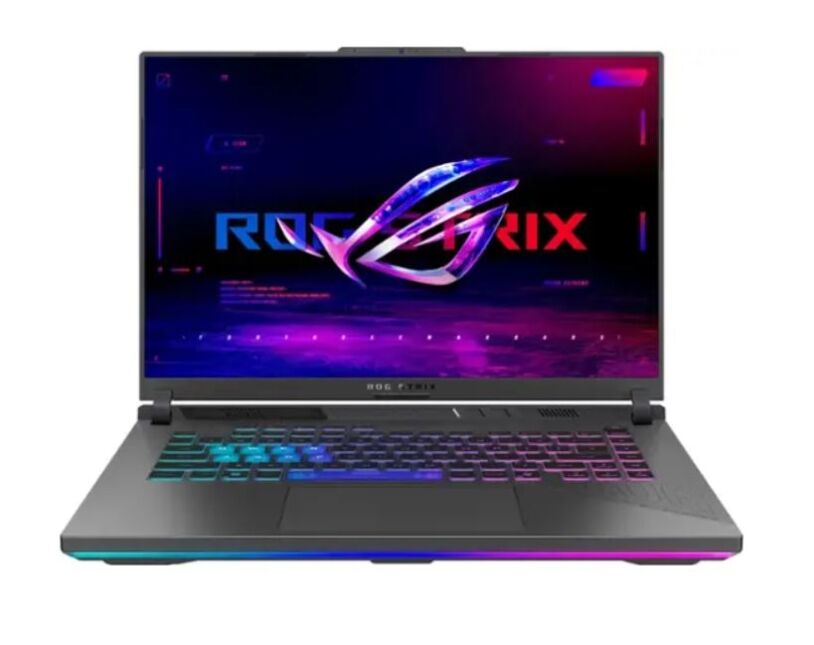
Specifications
- CPU: Intel Core Ultra 9 275HX
- GPU: Nvidia GeForce RTX 5070 Ti
- Memory: Up to 32GB DDR5
- Storage: Up to 2TB SSD
- Max Refresh Rate: 165Hz / 240Hz
- Resolution: 1900 x 1200 / 2560 x 1600
The ASUS ROG Stri G16x might not come with all the bells and whistles of the SCAR laptop above, nor have quite the same build quality, but it can still offer you a fantastic gaming experience at a very reasonable price. You can pick up either a 165Hz 1200p model or a 240Hz 1600p option, with either an RTX 5070 or 5070 Ti GPU. In terms of the CPU you can pick from either Intel Core Ultra 200 Series or up to AMD Ryzen 9 HX, and it’s nice to have that choice.
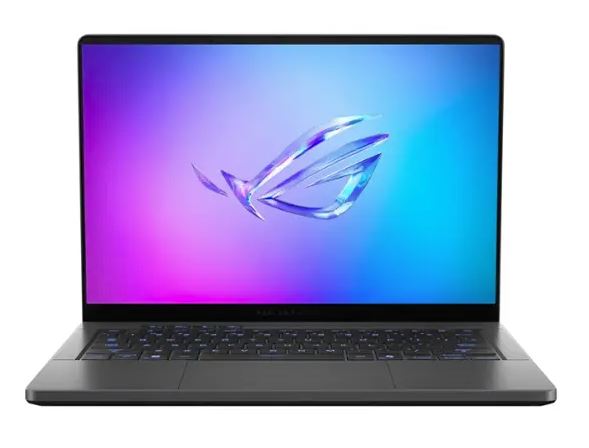
Specifications
- CPU: Up to AMD Ryzen AI 9 HX
- GPU: Nvidia GeForce RTX 5070 Ti
- Memory: Up to 32GB LPDDR5X 7500MHz
- Storage: unknown
- Max Refresh Rate: 120Hz
- Resolution: 3K
- Panel Type: OLED (100% DCI-P3, G-SYNC)
- Weight: 1.5kg
The ASUS Zephyrus series stands out for its slim, lightweight design, making it an excellent alternative to MacBooks or Surface devices for productivity while still delivering solid gaming performance. The 2025 models retain last year’s sleek chassis, featuring a programmable LED display on the lid for those who like customization. Available in 16-inch (G16) and 14-inch (G14) versions, the G14 remains a highlight, consistently ranking among the best compact gaming laptops. This year the G16 can be equipped with either an Intel or Ryzen CPU, along with an RTX 5070 or 5070 Ti, but the G14 is limited to the Ryzen processors (not that we’re complaining), such as the Ryzen AI 9 HX.
The G14 impresses with a 3K OLED display, G-Sync support, full DCI-P3 color accuracy, and a 120Hz refresh rate, while the G16 boasts a 2.5K panel at 240Hz. All models also include WiFi 7 for faster, more reliable connectivity. ASUS mitigates the thermal issues caused by the thin chassis with advanced cooling tech, including a Vapor Chamber and liquid metal thermal compounds.
Acer
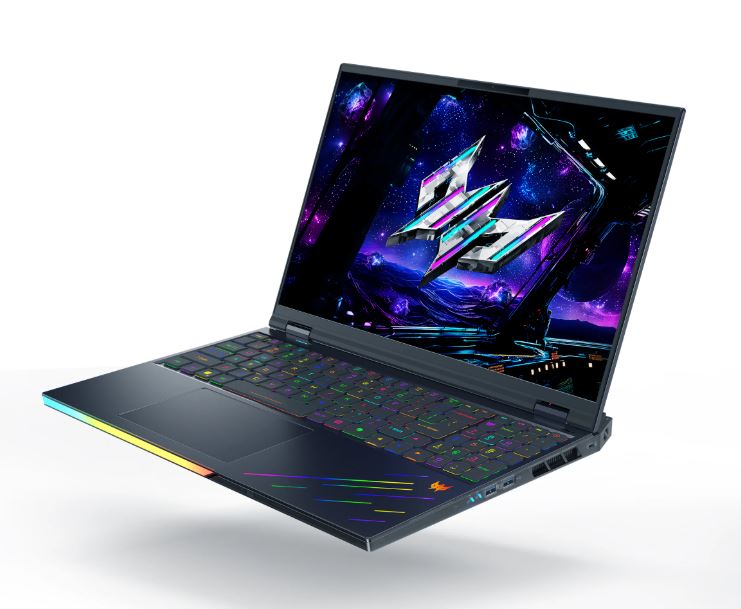
Specifications
- CPU: Up to Intel Core Ultra 7 255HX / Ultra 9 275HX
- GPU: Nvidia GeForce RTX 5070 / RTX 5070 Ti
- Memory: Up to 64GB DDR5 6400MHz
- Storage: Up to 2TB PCIe Gen4 SSD
- Max Refresh Rate: 250Hz / 240Hz / 165Hz
- Resolution: 2560 x 1600 / 1920 x 1200
- Panel Type: Mini-LED / LED
- Dimensions: 400.96 x 307.9 x 14.9/28mm
- Weight: 3.3kg
- Camera: FHD (1920×1080) IR camera
Show more
This year Acer are releasing five different laptops within their Predator Helios range: a 16-inch and 18-inch version of the standard Predator Helios, which are a bit thicker, plus come with WiFi 7, MagKey 4.0 for the WASD keys, PICe 5, improved fans, and slightly better build quality among other tweaks. The 18” model only comes with an RTX 5080 or 5090 though, so isn’t suitable for this guide. The Helios variants of both these laptops lack the features listed above, but are cheaper and come with the same horsepower under the hood in terms of the CPU options, which is ultimately what we care about. Both sizes of the Neo can be equipped with either an RTX 5070 Ti or 5070 GPU. The Acer Predator Helios Neo 18 AI also has the same 240Hz Mini-LED display as the standard variant, which we’re very pleased about.
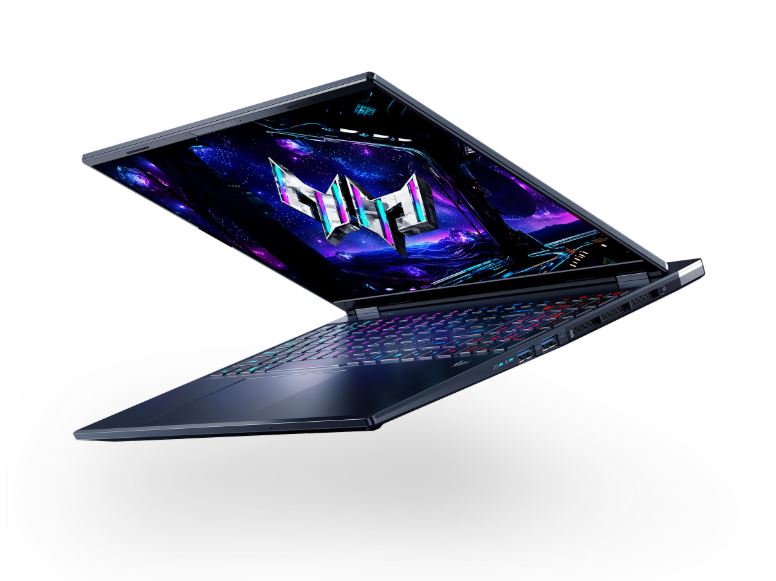
Specifications
- CPU: Up to Intel Core Ultra 7 255HX / Ultra 9 275HX
- GPU: Nvidia GeForce RTX RTX 5070 Ti
- Memory: Up to 64GB DDR5 6400MHz
- Storage: Up to 2TB PCIe Gen4 SSD
- Max Refresh Rate: 240Hz / 165Hz
- Resolution: 2560 x 1600
- Panel Type: OLED
- Dimensions: 356.78 x 275.5 x 12.0-19.9mm
- Weight: 2.3kg
- Camera: FHD (1920×1080) IR camera
Show more
If you’re looking for a 16-inch Acer Predator model with an RTX 5070 or 5070 Ti then you have three options to choose from: the standard Predator Helios 16 AI, the Predator Helios Neo 16 AI, or the Predator Helios Neo 16S AI, and it’s the latter of these that piques our interest the most. As with the 18-inch laptop, the standard Helios 16 AI comes with all the additional bells and whistles described above plus the option for more powerful core components and more SSD storage, however, it costs the most money. The Helios Neo 16 is a cheaper version of this that is limited to WiFi 6E, PCIe Gen 4, older fan tech, and Thunderbolt 4. Finally, the Helios Neo 16S AI is a slimline, extra-portable version of the Neo 16 that only measures 20mm at its thickest point but still comes with the same CPU options as the other two laptops, plus the option for an RTX 5070 Ti GPU, a 210Hz/165Hz 1600p OLED display, up to 2TB of storage, and 32GB of DDR5 RAM. It does have a smaller 76Whr battery (compared to the 90Whr in the other two), which is a bit of a trade-off, but it looks like it could be a great option for creators and gamers on the go.
MSI
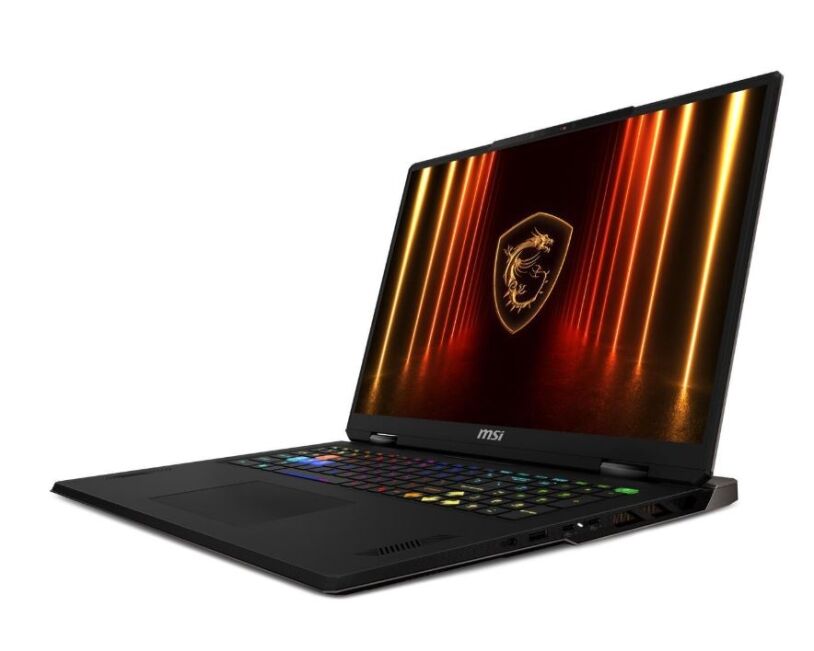
Specifications
- CPU: Up to AMD Ryzen 9 9955HX
- GPU: Nvidia GeForce RTX 5070 Ti
- Memory: Up to 32GB DDR5 5600MHz
- Storage: Up to 2TB SSD
- Max Refresh Rate: 240Hz
- Resolution: 2560 x 1600
- Panel Type: LED
- Dimensions: 15.91″ x 12.09″ x 1.26″
- Weight: 7.94lbs
Show more
The MSI Vector is the company’s more affordable gaming laptop line, which can be equipped with similar core specs to the more premium Raider series, but doesn’t match it in terms of cooling, premium display options, memory and storage capacity, build quality, and RGB. Still, you can get up to 32GB of DDR5 RAM and 2TB of SSD storage on these bad boys, and a 240Hz 1600p screen for quite a reasonable price.
We’ve seen an 18-inch version of the laptop with the option for the powerful AMD Ryzen 9 9955HX, so those looking for a Ryzen CPU option, but you can also get an Intel Core Ultra 9 275HX model or an Intel Core Ultra 7 255HX model with 1200p display for very cheap (only $1,599).
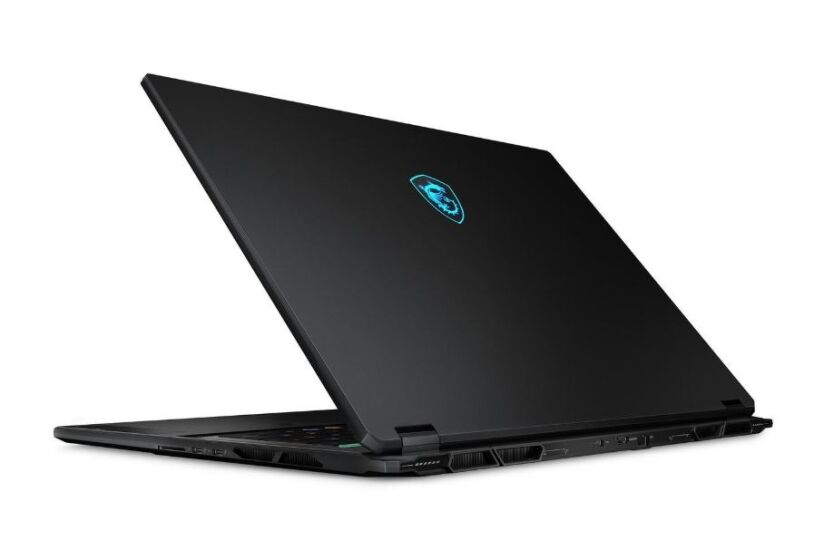
Specifications
- CPU: Up to Intel Core Ultra 9 275HX
- GPU: Nvidia GeForce RTX 5070 Ti
- Memory: Up to 64GB DDR5 5600MHz
- Storage: Up to 2TB SSD
- Max Refresh Rate: 240Hz
- Resolution: 2560 x 1600
- Panel Type: LED
- Dimensions: 15.74″ x 11.41″ x 0.94″
- Weight: 6.39lbs
Show more
The Stealth line are the slimmer and lighter models of MSI’s creative/gaming laptops, that typically lack the Wattage of the thicker boys, meaning reduced power to the CPU and GPU, but still come with some impressive core spec options that can handle most AAA games on the higher settings. Despite the thinner size, you can also equip the laptop with an impressive 64GB of DDR5 RAM and 2TB of SSD storage.
RTX 5070 laptop release date & RTX 5070 Ti laptop release date window
As you can see from the image below, taken from Nvidia’s site, RTX 5070 Ti laptops will be released first in the month of March, with RTX 5070 laptops coming a bit later in April. We don’t have a specific date yet for either, however, and the likelihood is that we won’t know in advance what dates they’ll land on – all we can suggest is to check the above retailers regularly throughout these months to see if the laptops are in stock.
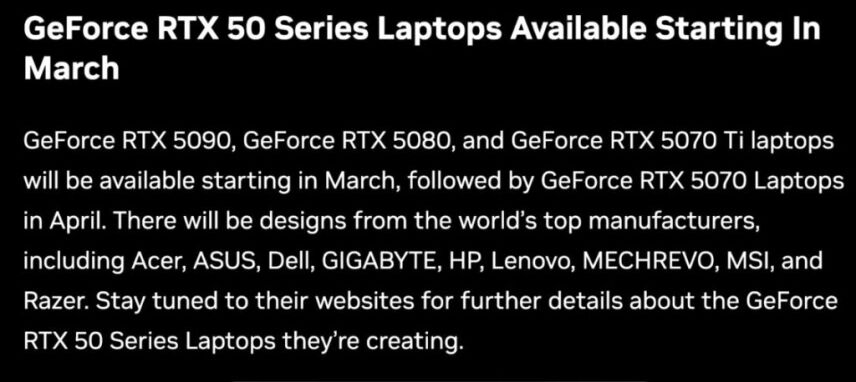
How much do RTX 5070 & 5070 Ti laptops cost?
As is fairly typical in the world of gaming laptops, the price range for both RTX 5070 and 5070 Ti laptops will vary considerably depending on the brand and the specific model. You could, for instance, get a more budget-friendly laptop that’s pretty stripped back in every other feature than the GPU, or conversely a model with a high-end CPU, the best display around, loads of RAM and storage, and great overall build quality. There’s also variation in terms of the amount of power (TGP) that is directed to the GPU between different laptops, which can have a big impact on performance and the price.
Of all the models listed on retailers, at the time of writing, we’ve seen the price range between $1,599 and $2,899 for RTX 5070 Ti laptops alone, which is a very big range. The extremes at either end of this range are fairly big outliers though: most RTX 5070 Ti laptops will cost around $2,200 if you’re in the US, give or take a couple of hundred dollars. RTX 5070 laptops will often retail around the $2,000 mark, though again with a fair bit of variance on either side.
RTX 5070 laptop vs 4070 laptop performance & specs
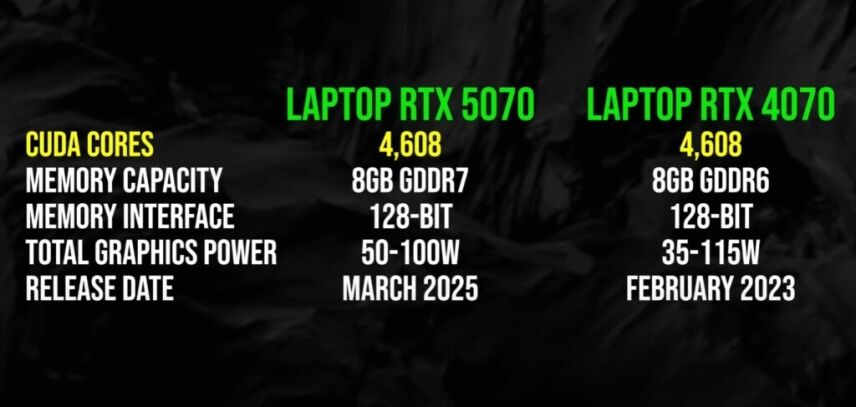
As detailed by the gaming laptop guru himself, Mr Jarrod’sTech, the core specs of the laptop RTX 5070 remain almost exactly the same as that of the laptop RTX 4070, with the same CUDA Core count, 8GB VRAM capacity, and 128-bit memory interface. The newer card is based on improved architecture, and has GDDR7 VRAM instead of the older GDDR6, so we hope to see some improvement to the raw performance, but it’s unlikely to be much of an uplift based on what we know, particularly given the upper TGP allowance caps out at 100W, compared to the 115W max of the RTX 4070.
We won’t know of course until the first laptops are independently benchmarked, but we imagine the majority of performance uplift will come from the multi-frame generation tech of DLSS 4. This alone could still make RTX 5070 laptops well worth buying, it ultimately depends on what the pricing ends up like relative to RTX 4070 machines (which may drop significantly in price), plus how appealing the updated CPU and other features end up being. Watch this space for our first reviews!

